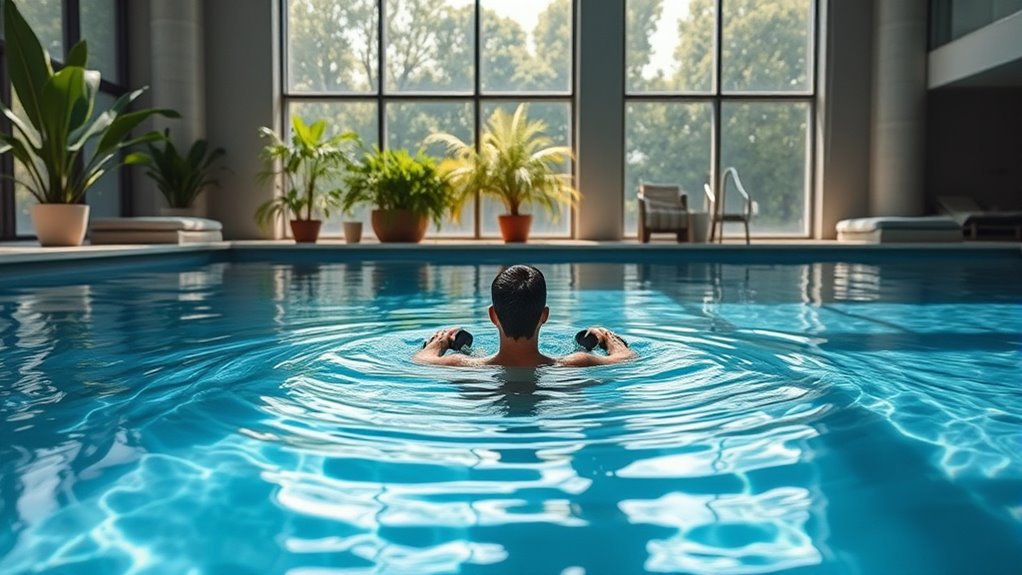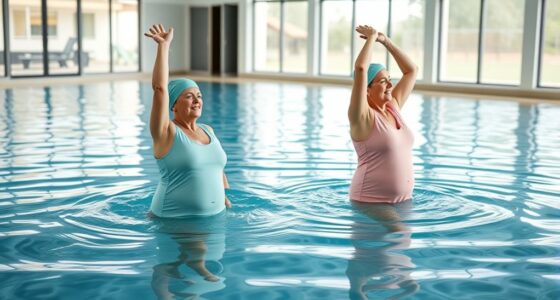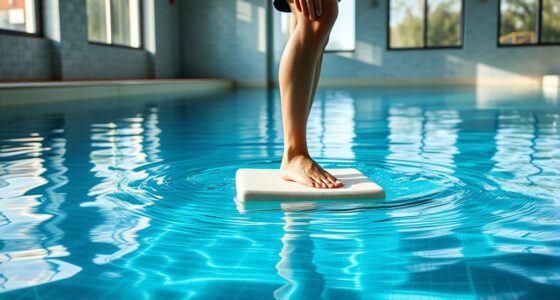Water therapy helps you heal faster after surgery by reducing pain and inflammation, making movement easier and less painful. It boosts circulation, which accelerates tissue repair, and supports gentle exercises that rebuild strength without stressing your body. The soothing environment eases anxiety and encourages consistent participation in your recovery plan. Stick with it, and you’ll discover how water therapy can enhance your healing process and overall well-being.
Key Takeaways
- Water therapy reduces pain, swelling, and inflammation, speeding up the healing process post-surgery.
- It provides gentle support, allowing safe, low-impact movements that improve mobility and prevent muscle atrophy.
- The soothing environment decreases anxiety and enhances relaxation, promoting faster recovery and emotional well-being.
- Aquatic exercises strengthen muscles gradually, increasing strength and flexibility without overstressing healing tissues.
- Regular water therapy sessions boost circulation, accelerate tissue repair, and foster confidence and independence during recovery.

Recovering from surgery can be challenging, but water therapy offers a promising way to speed up your healing process. The gentle support of water reduces the strain on your joints and muscles, making it easier to move without pain or fear of injury. Hydrotherapy benefits extend beyond mere comfort; it promotes circulation, reduces swelling, and accelerates tissue repair. When you engage in aquatic exercise, the buoyancy helps you perform movements that might be difficult or impossible on land, encouraging a more active recovery. This increased activity boosts blood flow, delivering essential nutrients to your tissues and removing waste products more efficiently, which is *essential* for healing.
Water therapy reduces pain, promotes circulation, and accelerates healing during recovery.
Aquatic exercise allows you to rebuild strength and flexibility gradually, without overstressing your healing tissues. The resistance of water provides a safe, low-impact environment where you can perform gentle movements that improve your range of motion. Over time, this helps prevent stiffness and muscle atrophy, common setbacks during recovery. By consistently participating in water therapy, you also enhance your mental well-being. The soothing properties of water can reduce pain perception and anxiety, making your rehabilitation journey more manageable. Many patients find that water therapy motivates them to stay committed to their recovery plan, because it feels less *intimidating* than traditional land-based exercises.
You don’t need to be an athlete to benefit from aquatic exercise. Even light movements in water can activate muscles and improve joint stability. Plus, water’s natural resistance helps strengthen your muscles without the need for weights or strenuous activity, which could risk setbacks. As you progress, your therapist can guide you through more challenging exercises, gradually increasing your strength and mobility. The key is consistency—regular sessions in water can lead to noticeable improvements faster than rest alone. The calming environment of a pool also fosters relaxation, easing tension in your body and mind, which is *crucial* during recovery.
Additionally, understanding the spiritual connection between water and healing can reinforce your motivation and emotional resilience during recovery. Incorporating hydrotherapy benefits into your post-surgery routine isn’t just about physical healing; it’s about creating a positive, proactive approach to your health. Whether you’re recovering from orthopedic surgery, a sports injury, or a medical procedure, aquatic exercise offers a safe, effective way to regain your strength and independence. With professional guidance, you’ll find that water therapy not only accelerates healing but also helps you feel more confident and in control during your recovery journey.
Frequently Asked Questions
Are There Specific Water Therapy Techniques Suited for Different Surgeries?
You might wonder if specific hydrotherapy modalities suit different surgeries. The answer is yes; tailored water therapy techniques can target your needs. For incision healing, gentle warm-water baths or hydro-massage help reduce swelling and improve circulation. For joint surgeries, exercises in a pool can restore mobility safely. Consult your healthcare provider to choose the best water therapy modality that promotes healing and minimizes discomfort based on your surgery type.
Can Water Therapy Replace Traditional Physical Therapy Methods?
Is water therapy a replacement or a complement? Think of aquatic exercises as a gentle symphony that boosts your healing. Hydrotherapy benefits include reducing pain, improving mobility, and accelerating recovery. While it’s a powerful tool, it can’t fully replace traditional physical therapy but works beautifully alongside it. You get the best of both worlds—strengthening muscles and easing joint stress in a supportive, water-filled environment.
How Soon After Surgery Can I Start Water Therapy Sessions?
You should wait until your doctor gives the go-ahead before starting water therapy after surgery. Timing considerations are vital, and your healthcare provider will assess your healing progress during initial assessments. They’ll determine if your body is ready for gentle water exercises, ensuring you don’t risk setbacks. Follow their advice closely, as starting too early can hinder recovery, while waiting too long might delay benefits.
Are There Any Risks or Contraindications for Water Therapy Post-Surgery?
Think of water therapy as a gentle river guiding your recovery, but watch for hidden rocks like infection risks or allergy concerns. You need to discuss these risks with your doctor, especially if you have sensitive skin or a history of infections. While water therapy can be healing, it’s essential to verify it’s safe for you, avoiding any complications that could turn your recovery journey into turbulent waters.
Does Water Therapy Benefit All Age Groups Equally During Recovery?
You might wonder if water therapy benefits all age groups equally during recovery. Age-specific considerations and developmental differences play a significant role; children, adults, and seniors each respond differently. While water therapy can be beneficial across ages, tailored adjustments are vital to address unique needs. Always consult your healthcare provider to ensure this therapy suits your age and recovery stage, maximizing safety and effectiveness.
Conclusion
Embrace water therapy as your healing ally, letting its gentle currents wash away pain and stiffness like a soothing tide. Imagine each session as a fresh sunrise, awakening your body’s resilience and guiding you toward faster recovery. By incorporating this calming practice, you turn the challenge of healing into a peaceful voyage—where every stroke and splash brings you closer to renewed strength and vigor. Immerse yourself in water therapy, and watch your recovery flow smoothly like a tranquil river.









